零基础入门C++(4)—程序流程结构
C/C++支持最基本的三种程序运行结构:顺序结构、选择结构、循环结构
- 顺序结构:程序按顺序执行,不发生跳转
- 选择结构:依据条件是否满足,有选择的执行相应功能
- 循环结构:依据条件是否满足,循环多次执行某段代码
1 选择结构
1.1 if语句
作用: 执行满足条件的语句
if语句的三种形式
- 单行格式if语句
- 多行格式if语句
- 多条件的if语句
-
单行格式if语句:
if(条件){ 条件满足执行的语句 }示例:
#include<iostream>
using namespace std;
int main() { //选择结构-单行if语句 //输入一个分数,如果分数大于600分,视为考上一本大学,并在屏幕上打印 int score = 0; cout << "请输入一个分数:" << endl; cin >> score; cout << "您输入的分数为: " << score << endl; //if语句 //注意事项,在if判断语句后面,不要加分号 if (score > 600) { cout << "我考上了一本大学!!!" << endl; }
return 0;
}
- 1
- 2
- 3
- 4
- 5
- 6
- 7
- 8
- 9
- 10
- 11
- 12
- 13
- 14
- 15
- 16
- 17
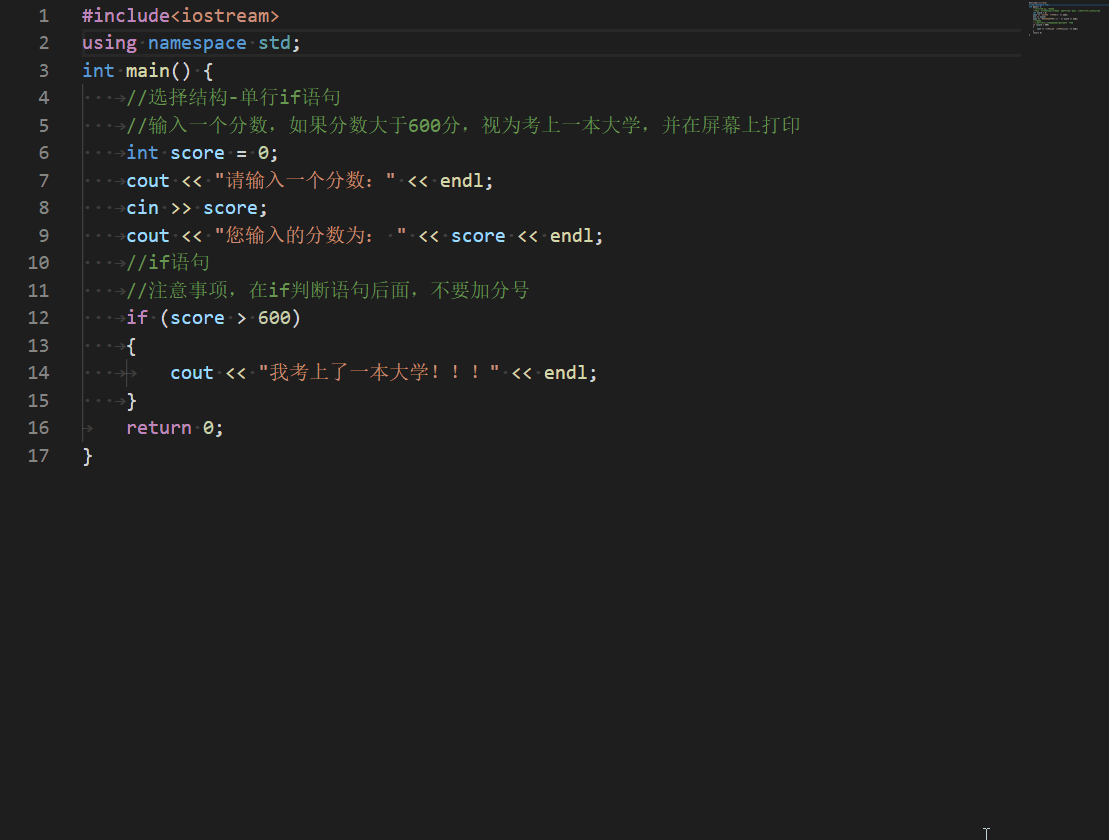
注意:if条件表达式后不要加分号
- 多行格式if语句:
if(条件){ 条件满足执行的语句 }else{ 条件不满足执行的语句 };
示例:
#include<iostream>
using namespace std;
int main() {
int score = 0;
cout << "请输入考试分数:" << endl;
cin >> score;
if (score > 600)
{
cout << "我考上了一本大学" << endl;
}
else
{
cout << "我未考上一本大学" << endl;
}
return 0;
}
- 1
- 2
- 3
- 4
- 5
- 6
- 7
- 8
- 9
- 10
- 11
- 12
- 13
- 14
- 15
- 16

3. 多条件的if语句:if(条件1){ 条件1满足执行的语句 }else if(条件2){条件2满足执行的语句}... else{ 都不满足执行的语句}
示例:
#include<iostream>
using namespace std;
int main() {
int score = 0;
cout << "请输入考试分数:" << endl;
cin >> score;
if (score > 600)
{
cout << "我考上了一本大学" << endl;
}
else if (score > 500)
{
cout << "我考上了二本大学" << endl;
}
else if (score > 400)
{
cout << "我考上了三本大学" << endl;
}
else
{
cout << "我未考上本科" << endl;
}
return 0;
}
- 1
- 2
- 3
- 4
- 5
- 6
- 7
- 8
- 9
- 10
- 11
- 12
- 13
- 14
- 15
- 16
- 17
- 18
- 19
- 20
- 21
- 22
- 23
- 24

案例需求:
- 提示用户输入一个高考考试分数,根据分数做如下判断
- 分数如果大于600分视为考上一本,大于500分考上二本,大于400考上三本,其余视为未考上本科;
- 在一本分数中,如果大于700分,考入北大,大于650分,考入清华,大于600考入人大。
示例:
#include<iostream>
using namespace std;
int main() {
int score = 0;
cout << "请输入考试分数:" << endl;
cin >> score;
if (score > 600)
{
cout << "我考上了一本大学" << endl;
if (score > 700)
{ cout << "我考上了北大" << endl;
}
else if (score > 650)
{ cout << "我考上了清华" << endl;
}
else
{ cout << "我考上了人大" << endl;
} }
else if (score > 500)
{
cout << "我考上了二本大学" << endl;
}
else if (score > 400)
{
cout << "我考上了三本大学" << endl;
}
else
{
cout << "我未考上本科" << endl;
}
return 0;
}
- 1
- 2
- 3
- 4
- 5
- 6
- 7
- 8
- 9
- 10
- 11
- 12
- 13
- 14
- 15
- 16
- 17
- 18
- 19
- 20
- 21
- 22
- 23
- 24
- 25
- 26
- 27
- 28
- 29
- 30
- 31
- 32
- 33
- 34
- 35
- 36
- 37
1.2 三目运算符
作用: 通过三目运算符实现简单的判断
语法:表达式1 ? 表达式2 :表达式3
解释:
如果表达式1的值为真,执行表达式2,并返回表达式2的结果;
如果表达式1的值为假,执行表达式3,并返回表达式3的结果。
示例:
#include<iostream>
using namespace std;
int main() {
int a = 10;
int b = 20;
int c = 0;
c = a > b ? a : b;
cout << "c = " << c << endl;
//C++中三目运算符返回的是变量,可以继续赋值
(a > b ? a : b) = 100;
cout << "a = " << a << endl;
cout << "b = " << b << endl;
cout << "c = " << c << endl;
return 0;
}
- 1
- 2
- 3
- 4
- 5
- 6
- 7
- 8
- 9
- 10
- 11
- 12
- 13
- 14
- 15

总结:和if语句比较,三目运算符优点是短小整洁,缺点是如果用嵌套,结构不清晰
1.3 switch语句
作用: 执行多条件分支语句
语法:
switch(表达式)
{
case 结果1:执行语句;break;
case 结果2:执行语句;break;
...
default:执行语句;break;
}
- 1
- 2
- 3
- 4
- 5
- 6
- 7
- 8
示例:
#include<iostream>
using namespace std;
int main() {
//请给电影评分
//10 ~ 9 经典
// 8 ~ 7 非常好
// 6 ~ 5 一般
// 5分以下 烂片
int score = 0;
cout << "请给电影打分" << endl;
cin >> score;
switch (score)
{
case 10:
case 9:
cout << "经典" << endl;
break;
case 8:
cout << "非常好" << endl;
break;
case 7:
case 6:
cout << "一般" << endl;
break;
default:
cout << "烂片" << endl;
break;
}
return 0;
}
- 1
- 2
- 3
- 4
- 5
- 6
- 7
- 8
- 9
- 10
- 11
- 12
- 13
- 14
- 15
- 16
- 17
- 18
- 19
- 20
- 21
- 22
- 23
- 24
- 25
- 26
- 27
- 28
- 29
- 30
注意1:switch语句中表达式类型只能是整型或者字符型
注意2:case里如果没有break,那么程序会一直向下执行
总结:与if语句比,对于多条件判断时,switch的结构清晰,执行效率高,缺点是switch不可以判断区间
2 循环结构
2.1 while循环语句
作用: 满足循环条件,执行循环语句
语法:while(循环条件){ 循环语句 }
解释:只要循环条件的结果为真,就执行循环语句
示例:
#include<iostream>
using namespace std;
int main() {
int num = 0;
while (num < 10)
{
cout << "num = " << num << endl;
num++;
}
return 0;
}
- 1
- 2
- 3
- 4
- 5
- 6
- 7
- 8
- 9
- 10
- 11

注意:在执行循环语句时候,程序必须提供跳出循环的出口,否则出现死循环
2.2 do…while循环语句
作用: 满足循环条件,执行循环语句
语法: do{ 循环语句 } while(循环条件);
注意: 与while的区别在于do…while会先执行一次循环语句,再判断循环条件
示例:
#include<iostream>
using namespace std;
int main() {
int num = 0;
do
{
cout << num << endl;
num++;
} while (num < 10);
return 0;
}
- 1
- 2
- 3
- 4
- 5
- 6
- 7
- 8
- 9
- 10
- 11
- 12

总结:与while循环区别在于,do…while先执行一次循环语句,再判断循环条件
2.3 for循环语句
作用: 满足循环条件,执行循环语句
语法:for(起始表达式;条件表达式;末尾循环体) { 循环语句; }
示例:
#include<iostream>
using namespace std;
int main() {
for (int i = 0; i < 10; i++)
{
cout << i << endl;
}
return 0;
}
- 1
- 2
- 3
- 4
- 5
- 6
- 7
- 8
- 9

注意:for循环中的表达式,要用分号进行分隔
总结:while , do…while, for都是开发中常用的循环语句,for循环结构比较清晰,比较常用
2.4 嵌套循环
作用: 在循环体中再嵌套一层循环,解决一些实际问题
# include<iostream>
using namespace std;
int main() {
//外层循环执行1次,内层循环执行1轮
for (int i = 0; i < 10; i++)
{
for (int j = 0; j < 10; j++)
{ cout << "*" << " ";
}
cout << endl;
}
return 0;
}
- 1
- 2
- 3
- 4
- 5
- 6
- 7
- 8
- 9
- 10
- 11
- 12
- 13
- 14

3 跳转语句
3.1 break语句
作用: 用于跳出选择结构或者循环结构
break使用的时机:
- 出现在switch条件语句中,作用是终止case并跳出switch
- 出现在循环语句中,作用是跳出当前的循环语句
- 出现在嵌套循环中,跳出最近的内层循环语句
示例1:
# include<iostream>
using namespace std;
int main()
{
//1、在switch 语句中使用break
cout << "请选择您挑战副本的难度:" << endl;
cout << "1、普通" << endl;
cout << "2、中等" << endl;
cout << "3、困难" << endl;
int num = 0;
cin >> num;
switch (num)
{
case 1:
cout << "您选择的是普通难度" << endl;
break;
case 2:
cout << "您选择的是中等难度" << endl;
break;
case 3:
cout << "您选择的是困难难度" << endl;
break;
}
return 0;
}
- 1
- 2
- 3
- 4
- 5
- 6
- 7
- 8
- 9
- 10
- 11
- 12
- 13
- 14
- 15
- 16
- 17
- 18
- 19
- 20
- 21
- 22
- 23
- 24
- 25
示例2:
# include<iostream>
using namespace std;
int main()
{
//2、在循环语句中用break
for (int i = 0; i < 10; i++)
{
if (i == 5)
{ break; //跳出循环语句
}
cout << i << endl;
}
return 0;
}
- 1
- 2
- 3
- 4
- 5
- 6
- 7
- 8
- 9
- 10
- 11
- 12
- 13
- 14
- 15
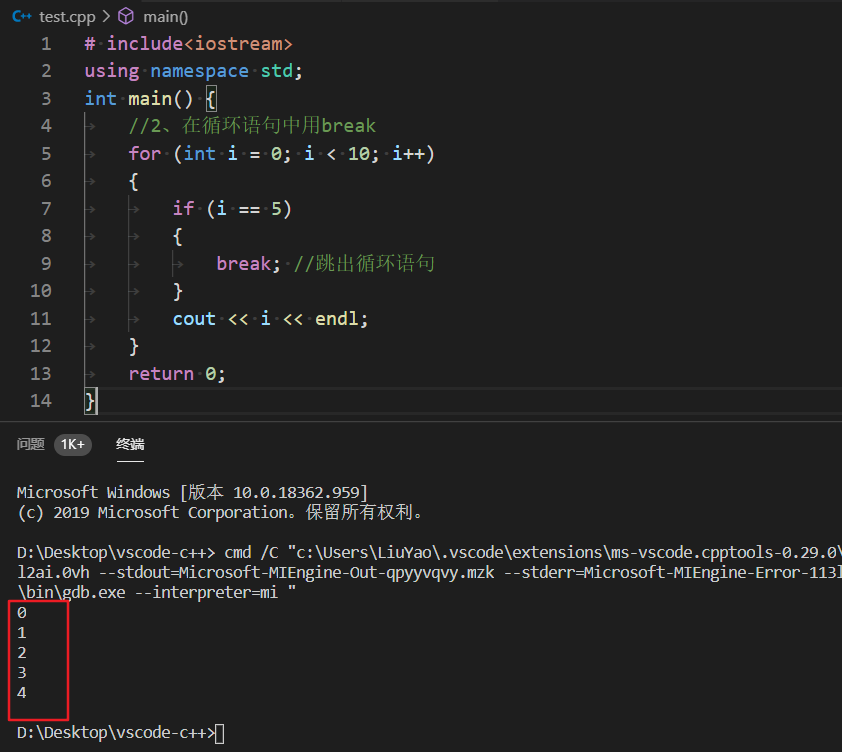
示例3:
# include<iostream>
using namespace std;
int main() {
//在嵌套循环语句中使用break,退出内层循环
for (int i = 0; i < 10; i++)
{
for (int j = 0; j < 10; j++)
{ if (j == 5) { break; } cout << "*" << " ";
}
cout << endl;
}
return 0;
}
- 1
- 2
- 3
- 4
- 5
- 6
- 7
- 8
- 9
- 10
- 11
- 12
- 13
- 14
- 15
- 16
- 17
- 18
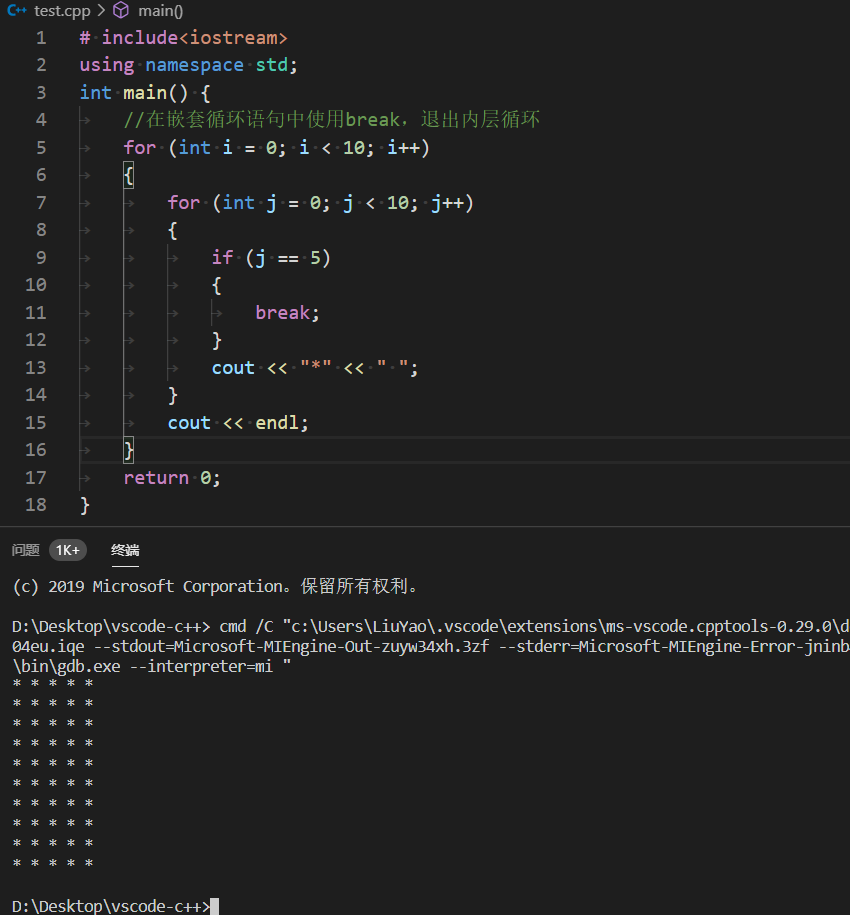
3.2 continue语句
作用: 在循环语句中,跳过本次循环中余下尚未执行的语句,继续执行下一次循环
示例:
# include<iostream>
using namespace std;
int main() {
for (int i = 0; i < 30; i++)
{
if (i % 2 == 0)
{ continue;
}
cout << i << endl;
}
return 0;
}
- 1
- 2
- 3
- 4
- 5
- 6
- 7
- 8
- 9
- 10
- 11
- 12
- 13
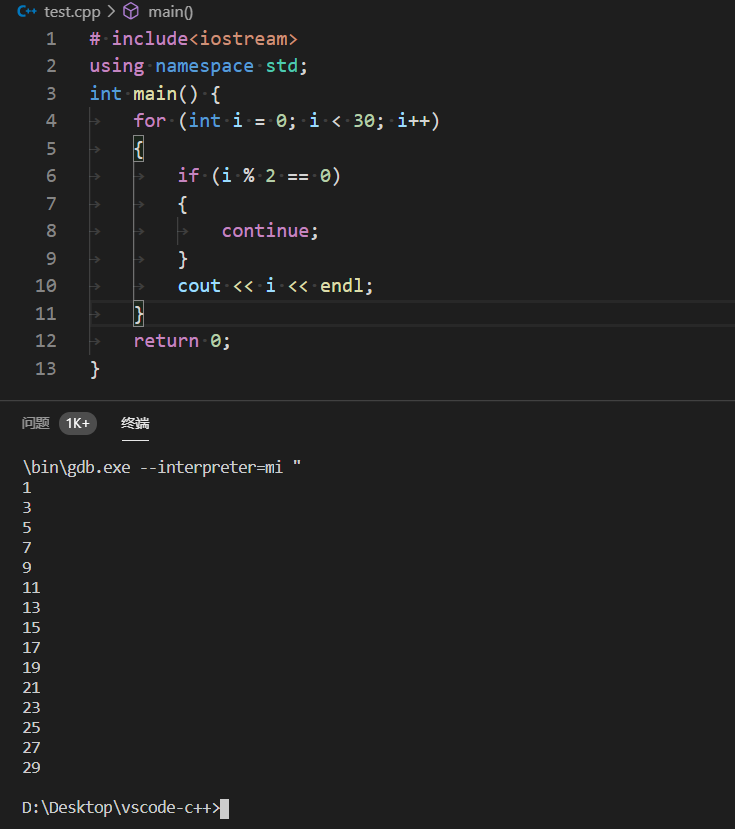
注意:continue并没有使整个循环终止,而break会跳出循环
3.3 goto语句
作用: 可以无条件跳转语句
语法: goto 标记;
解释: 如果标记的名称存在,执行到goto语句时,会跳转到标记的位置
示例:
# include<iostream>
using namespace std;
int main() {
cout << "1" << endl;
goto FLAG;
cout << "2" << endl;
cout << "3" << endl;
cout << "4" << endl;
FLAG:
cout << "5" << endl;
return 0;
}
- 1
- 2
- 3
- 4
- 5
- 6
- 7
- 8
- 9
- 10
- 11
- 12
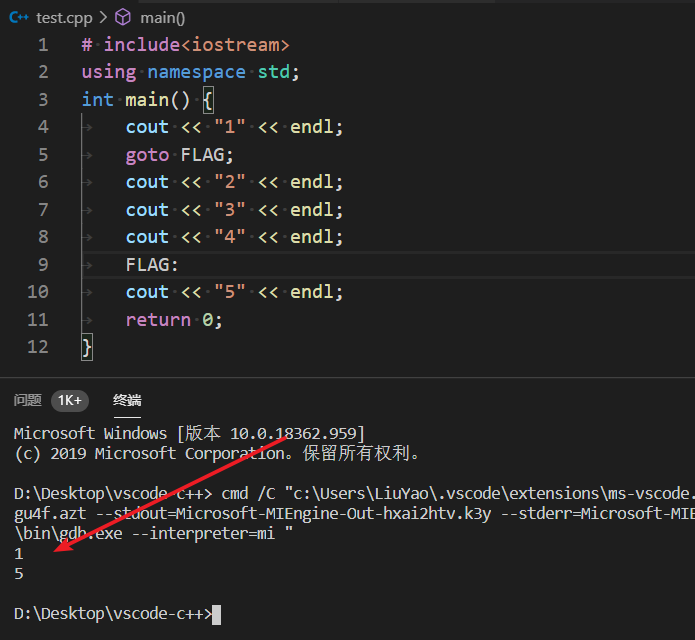
注意:在程序中不建议使用goto语句,以免造成程序流程混乱
文章来源: blog.csdn.net,作者:果果小师弟,版权归原作者所有,如需转载,请联系作者。
原文链接:blog.csdn.net/qq_39400113/article/details/107602012
- 点赞
- 收藏
- 关注作者


评论(0)